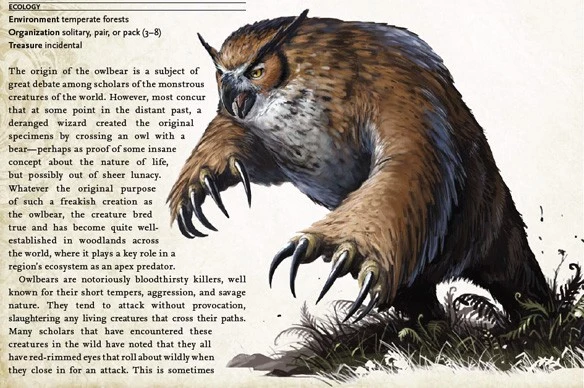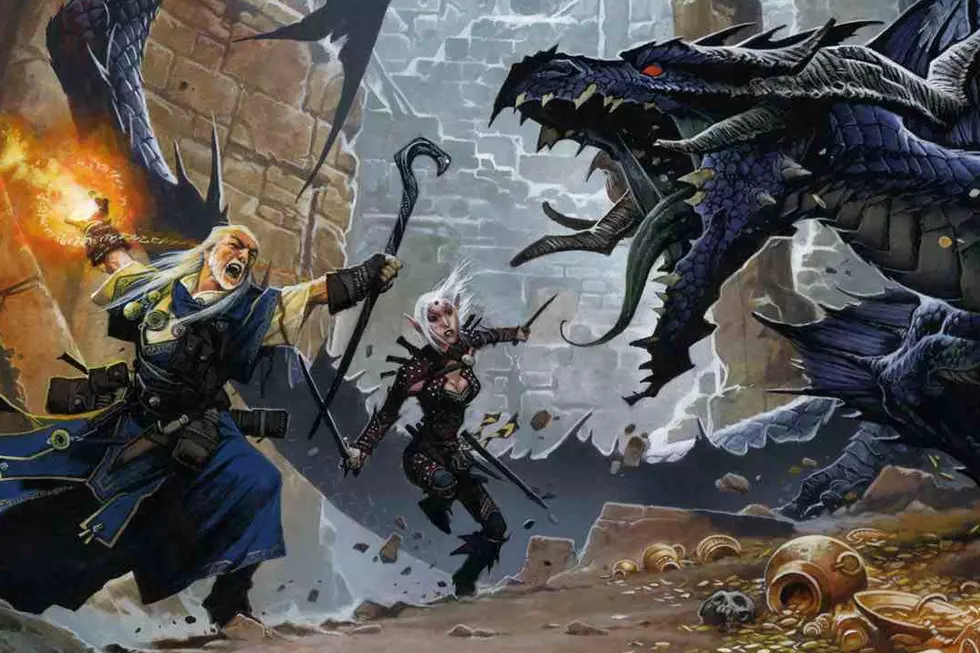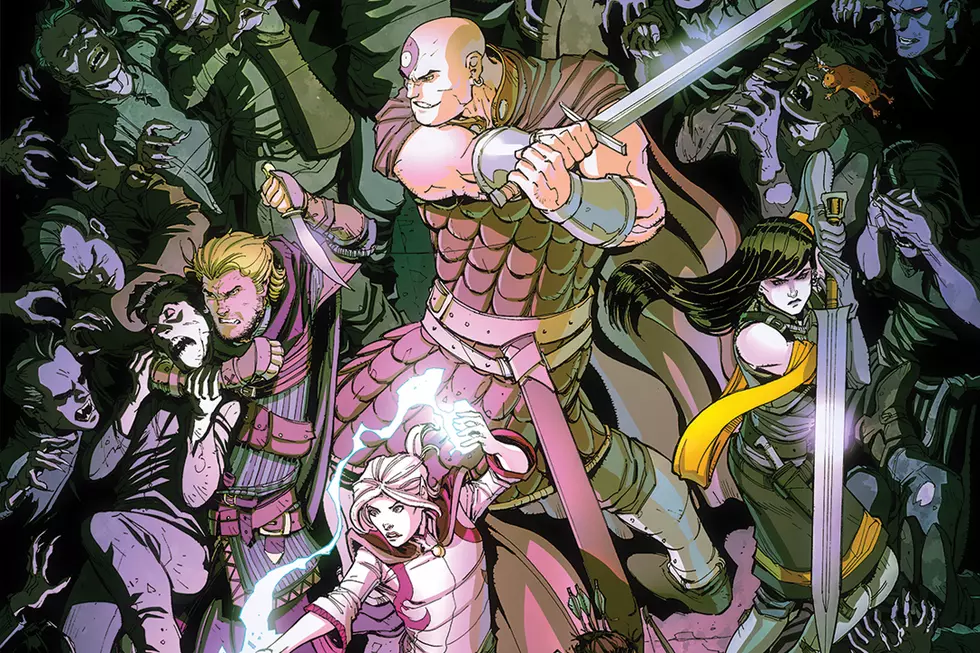
Ask Chris #125: The Greatest Monsters in ‘Dungeons & Dragons’
Over a lifetime of reading comics, Senior Writer Chris Sims has developed an inexhaustible arsenal of facts and opinions. That's why each and every week, we turn to you to put his comics culture knowledge to the test as he responds to your reader questions -- and as Halloween approaches, we make those questions spoooooky.

Q: What are the best monsters in the D&D Monster Manual? -- @doubting_tom
A: Around this time every year, I become slightly more obsessed with monsters than I am for the rest of the year, but this question has taken things into a whole new direction. It's pretty standard to go through all the reasons why Draculas, Wolfmans and assorted Frankensteins are interesting or relevant, but when you start talking about the monsters that pop up in roleplaying games, there's an entirely different set of factors determining how they interact and what they represent.
Mostly, it's just that wizards are f**king weird. But I'll get back to that in a second. Before we go any further, I want to own up to the fact that I don't actually have a Monster Manual handy, so instead, I'm going to be using the Pathfinder Bestiary. For those of you who may not know, Pathfinder was the game that came out of D&D rebooting into its 4th Edition, essentially streamlining the existing 3.5 system that traded video game-style simplicity for a more robust customization that allowed for -- you know what? This may actually be too nerdy for the weekly Q&A column on a comic book news site. Just rest assured that it's basically the same thing and we can all move on.
Before we go any further, I want to own up to the fact that I don't actually have a Monster Manual handy, so instead, I'm going to be using the Pathfinder Bestiary. For those of you who may not know, Pathfinder was the game that came out of D&D rebooting into its 4th Edition, essentially streamlining the existing 3.5 system that traded video game-style simplicity for a more robust customization that allowed for -- you know what? This may actually be too nerdy for the weekly Q&A column on a comic book news site. Just rest assured that it's basically the same thing and we can all move on.
The thing about monsters in an RPG is that they represent a completely different thing than their counterparts do in virtually every other medium. The best monsters, the ones that we all remember and enjoy reading or watching movies about, always tend to be very symbolic, whether it's Dracula luring chaste young women away from their stuffy boyfriends or zombies as a metaphor for the inescapable inevitability of death. In an RPG, they don't really mean those things. They're reduced to a set of stats and abilities that are designed to give the players an enjoyable and interesting challenge.
That might sound a little dismissive, but that's just a function of how the game works. A doppelgänger in D&D isn't a weird, unsettling omen of death for anyone who sees it, it's a challenge suitable for a party of four Level 3 player characters. It's been stripped of its context so that you can drop it into a game of your own, and there's no intrinsic meaning to it other than what the GM and the players assign to it, usually in the form of a plot twist about how the local baron was actually dead the whole time! Even dragons, the iconic symbol of the entire fantasy genre, don't really represent the ultimate foe that can be slain by warriors of uncommon nobility and purity of heart; they're color-coded and arranged into size categories so you know which ones you should be fighting at any given time.
Of course, that blindness to symbolism can have its downside, especially when you start considering that it's a pretty standard strategy to take an existing Good Guy race, give 'em black skin and declare them to be a wholly evil population that should be wiped out immediately if not sooner. Seriously, did nobody stop for a second to think through the concept of dark elves and realize that it was a little problematic?
Anyway, that's a topic for another time. What matters is that you have to take a different approach to thinking about these things, and as mentioned above, there are factors to take into account that go far beyond any symbolic intent that these creatures may have had when they were created. And the first one is that monsters are everywhere.
Let's be honest here: In the real world, if you saw a two foot-tall green thing running at you with a butcher knife screaming about how it wanted to feed your blood to Tiamat or whatever, you would lose your mind. In D&D and its extended family of games, however, goblins are just something you're going to have to deal with if you ever plan on going outside at all. And that's not just in those untamed wilds between the flickering lights of civilization, either. Got a tree in your backyard? Chances are pretty good that there's a Dryad living there rent-free, assuming of course that the tree itself is not actually capable of getting up and wandering around looking for something to punch, which it probably is. Ever see an old trunk up in the attic? Well if grandma had class levels, that thing is probably a mimic, just waiting for you to go up there looking for an extra blanket. It's a pretty nightmarish world of constant danger, where you are no more than, say, ten minutes away from a giant brain with chicken legs trying to eat you at any given time:

But at the same time, that danger's actually pretty easy to deal with. Your average farmer (6 HP at Level 1) is fully capable of being stabbed right in the face with a dagger and cold walking it off, and that's before you even throw adventurers into the mix. If even 1% of the population is devoted to wandering around killing green people for money -- and it makes sense that they would be, since fantasy RPGs tend to have a pretty solidly murder-based economy -- then a town with 200 people in it most likely has at least one person capable of literally resurrecting the dead once per day.
As a result, you have to look at things a little differently than we do. Much like superhero comics, RPGs treat death as more of an inconvenience than anything else. For a player character, it's pretty easy to wander back from the afterlife, and even if it's not, you can just roll up another one and be waiting at the next tavern. That's why the most feared D&D monster isn't one that'll kill you, it's one that goes after what really matters: Your stuff.
Thus: the Rust Monster. Better known (in my gaming circles at least) as the Dick Move.

Seriously, a vampire might drain your corpse of blood and resurrect it as an undead puppet, sent to battle the friends that you once trusted with your life and force them to destroy your body, but a Rust Monster? It eats your armor and your weapons! Do you have any idea how many home invasions -- uh, I mean, "dungeon crawls" you have to go on to get a +2 flaming burst longsword? All that fun you had with your friends was all for nothin', man!
The Rust Monster also illustrates the third important factor in D&D monsters, which is that the world operates on an extremely well-defined set of rules, and while nobody in the game tends to mention that, the people designing it are extremely aware of that fact. Because of that, those monsters that are scattered all over the world tend to operate on truly bizarre principles. The Rust Monster's entire strategy for survival is to stand around waiting for someone to come along and hit it with a weapon, and I don't care how fast it can eat a broadsword, that road leads to a mass extinction toute de suite.
The same goes for the aforementioned Mimic. It is a creature that somehow evolved to sit in forgotten tombs that no one has ventured within for a thousand years, lined with sinister traps, disguised as a treasure chest in hopes that someone will try to open it. That is seriously how that monster works.
Of course, evolution doesn't always have a hand in it, which brings us to the most important aspect of how monsters developed. As mentioned above, wizards are f**king weird.
Not only does magic exist in the world of D&D, but it's apparently been employed by complete and utter lunatics in order to shape the very ecology of the world. And I know this because of The Owlbear.

The Owlbear is probably the second-greatest monster in the history of D&D, if only because it makes absolutely no sense. As Rich Burlew pointed out in Order of the Stick, the premise of the Owlbear is taking a very fearsome, very dangerous animal, the bear, and then combining it with a smaller, significantly less threatening animal, the owl. The end result: Bear with feathers. Genius.
It's important to note that the Owlbear cannot fly. It's just a bear with completely nonfunctional, decorative feathers, and it is genuinely heartbreaking that the person who came up with such a thing and then encouraged millions of people to take it very, very seriously is not lauded as one of the true geniuses of our age. My favorite part? That the actual, in-continuity reason for the Owlbear's existence is literally "I dunno, some crazy old wizard did it." Really. I left the text in so you can see for yourself.
So, put all that together and what do we have? An extremely dangerous world where items are more valuable than lives, that operates on a strictly defined set of rules, and that has been shaped by crazy people with access to unlimited reality-altering magic. In a world like that, there can be no question of what is the greatest monster.
It's gotta be the Cube.

The Gelatinous Cube is amazing. If I had my way, Dungeons & Dragons would be retitled as Caverns & Cubes, because some scaly, fire-breathing stack of nonsense has nothing on this thing. When you get right down to it, I love it for the same reason that I love Jimmy Olsen, the character that could only exist in a world that had already been defined by superheroes. It's the monster that could only exist in D&D, because it only makes sense in a world that follows that kind of logic.
If you're not familiar with it, here's how the Gelatinous Cube works. It is, as you might expect, exactly what it says it is: A 10 foot-tall cube made of a semi-sentient, self-propelling acidic ooze designed to patrol 10' wide corridors in order to keep them free of dust, rodents, and the occasional adventuring party. And not only that, but it's almost transparent, so it's a 10' tall mindless gelatin that can actually sneak up on you, and while its acid can dissolve flesh, it leaves your weapons and armor clean and tidy so that it can deposit them later at a treasure horde.
This is soomething that can only exist -- can only have any sort of reason to exist whatsoever -- in a world in which sprawling subterranean labyrinths designed to fit a grid system and owned by obsessive-compulsive neat-freak sorcerors are as common as, say, grass.
It's the wizardly equivalent of a Roomba. And that is fantastic in every sense of the word.
That's all we have for this week, but if you've got a question you'd like to see Chris tackle in a future column, just send it to @theisb on Twitter with the hashtag #AskChris, or send an email to chris@comicsalliance.com with [Ask Chris] in the subject line!
More From ComicsAlliance









